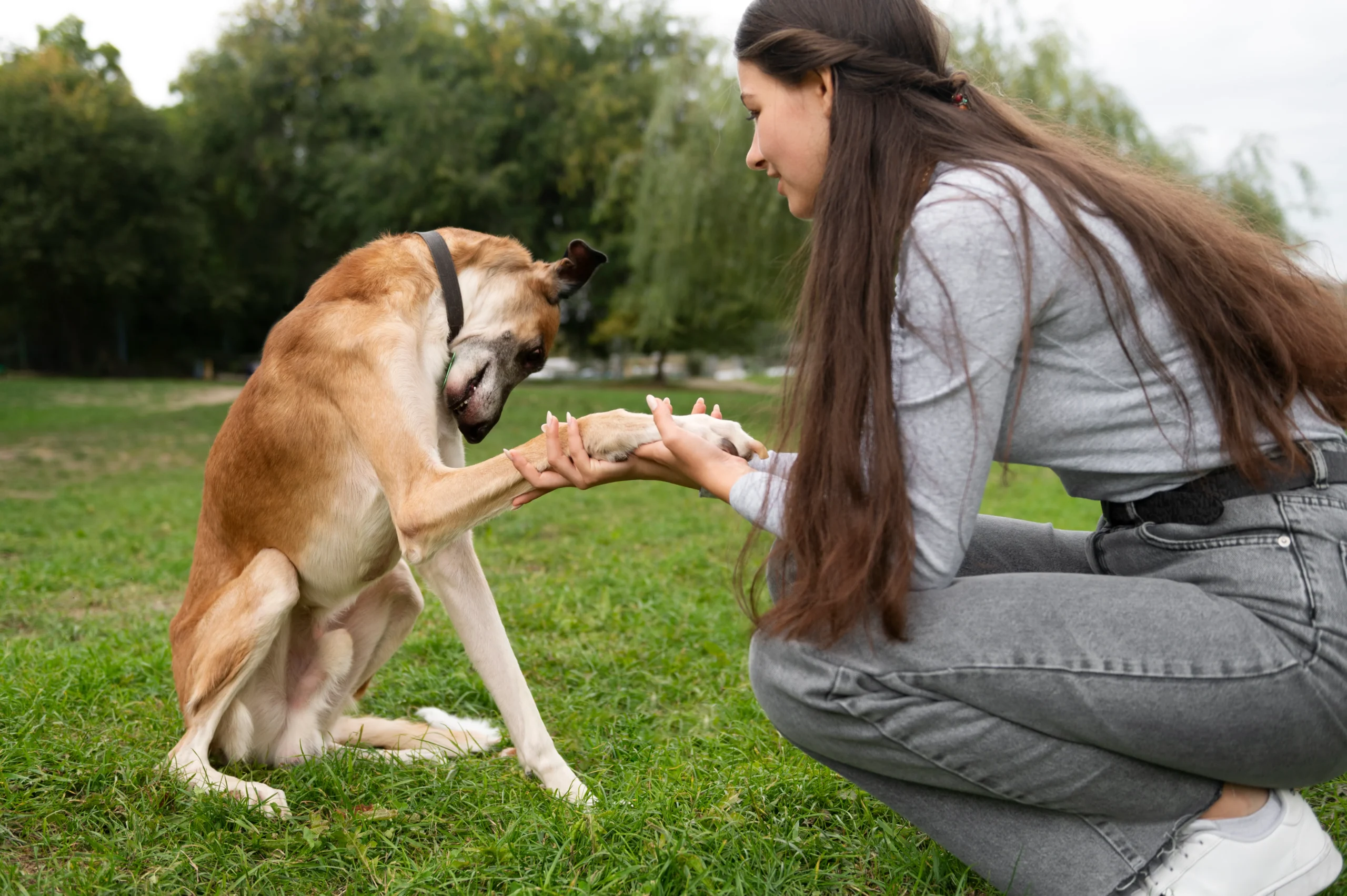Are you concerned that your furry pal may be suffering from arthritis? Arthritis, a joint pain illness, is unfortunately quite common in our aging canine companions. This blog will walk you through the various symptoms of arthritis in dogs and offer advice on managing their discomfort better.
Key Takeaways
- Your dog may be experiencing joint pain and fatigue associated with arthritis, including mobility problems such as walking or climbing stairs.
- Limping or lameness could be a sign of arthritis, as dogs often favor one leg or avoid putting weight on a specific limb due to joint inflammation or degeneration.
- Dogs with arthritis may yelp when touched due to inflammation in the joints. This sensitivity can also lead to behavior changes such as increased irritability and even snapping or biting actions.
- Excessive licking, chewing, and biting of certain body parts are common behaviors exhibited by dogs with arthritis as they try to alleviate the pain they feel in their joints.
Signs and Symptoms of Arthritis in Dogs
Dogs with arthritis may show signs of reluctance to move, limp or be lame, yelp when touched, exhibit irritability and changes in behavior, excessive licking, chewing, and biting, tiredness or lethargy, muscle atrophy, difficulty getting comfortable, “bathroom” related accidents or difficulty squatting or lifting their leg properly. Additionally, dogs may experience stiffness in their joints and increased fatigue.
Reluctance to Move
Arthritis can cause your dog to be hesitant when it comes to movement. Climbing stairs or going for walks may suddenly become arduous tasks, and you might notice a lag in their stride.
Such changes signal joint pain and mobility issues commonly associated with this condition. Arthritic dogs often favor quiet areas over their usual hangouts, reducing interaction as they opt for solitude.
Limping/Lameness
Limping or lameness stands out as a significant sign of arthritis in dogs. The disease tends to cause joint pain and discomfort, forcing your furry friend to favor one leg or avoid putting weight on a specific limb.
Yelping when Touched
Dogs expressing pain by yelping when touched is a clear symptom of arthritis. This sensitivity to touch is often due to joint inflammation, making even gentle caresses or petting uncomfortable for your furry friend.
Irritability
Irritability is a common sign of arthritis in dogs. When dogs are experiencing pain, they may become irritable and easily agitated. Additionally, when touched, they may yelp or even snap or bite as a reaction to their discomfort.
Changes in Behavior
Dogs with arthritis often experience changes in behavior. They may become irritable and more prone to snapping or biting when someone tries to touch them. Pain may make them seek out quiet areas, and you may notice they prefer solitude over companionship.
Excessive Licking, Chewing, & Biting
Arthritis can cause dogs to exhibit excessive licking, chewing, and biting behaviors. These actions are often their way of trying to alleviate the pain they feel in their joints. Sometimes, arthritic pets will focus on specific areas that are more painful, causing them to lick or bite at those spots constantly.
Tiredness or Lethargy
Tiredness or lethargy is one of the signs that your dog may be experiencing arthritis. When dogs are in pain, they tend to have reduced activity levels and increased resting or sleeping.
Muscle Atrophy
Muscle atrophy is a common sign of arthritis in dogs. When dogs have arthritis, they often become less active due to joint pain and stiffness. As a result, their muscles can weaken and shrink over time.
Difficulty Getting Comfortable
Dogs with arthritis often struggle to find a comfortable position, especially when trying to sleep or rest. This is because the joint pain and stiffness can make it difficult for them to find a position that alleviates their discomfort.
Changes in "Bathroom" Behavior
Arthritis in dogs can affect their toileting behavior. Some common signs to watch out for include difficulty with standard movements like standing up or sitting down. Arthritic dogs may also have trouble going up or down stairs or experience mobility issues during walks.
Stiffness
Stiffness is a common sign of arthritis in dogs. When dogs have arthritis, it causes changes in their joints that can lead to stiffness and pain. This stiffness may make it difficult for them to move around, such as going up or down stairs.
Sleeping More
Sleeping more can be a sign and symptom of arthritis in dogs. Dogs in pain may spend more time in quiet areas and not follow their owners around. Pain can be exhausting for dogs, leading to decreased activity and increased resting or sleeping.

Changes in Temperament
Arthritis can significantly affect a dog’s temperament. Dogs in pain may become irritable and display changes in behavior, such as spending more time in quiet areas and not following their owners around.
Changes in body shape
Arthritis in dogs can lead to changes in their body shape. This is because the affected joints may undergo alterations, resulting in limited mobility and painful movement. One common change is muscle atrophy, where certain muscles deteriorate over time due to decreased activity.
Phobias
Phobias can be a sign of arthritis in dogs and can cause them to exhibit certain behaviors. For example, they may become reluctant to move or favor certain legs due to their fear of pain.
Changes in coat (patterns/directions of fur)
Changes in a dog’s coat, such as alterations in patterns and directions of fur, can serve as indicators of arthritis. When a dog is experiencing arthritic pain, their coat may undergo noticeable changes.
Asymmetrical nail wear
Asymmetrical nail wear can be a telltale sign of arthritis in dogs. When a dog has arthritis, the pressure and strain on their joints can lead to uneven nail wear. This means certain nails may be shorter or more worn down than others.
Panting
Panting can be one of the signs that your dog is experiencing pain from arthritis. Dogs with arthritis may pant because they are sensitive to touch in their affected joints. This discomfort can cause them to exhibit changes in behavior, such as becoming more irritable and even snapping or biting when touched.
Lower head carriage
Lower head carriage is a potential sign of arthritis in dogs. When a dog is experiencing pain and discomfort in their joints, they may lower their head to alleviate some of the pressure and relieve the discomfort.
Loss of appetite
Dogs with arthritis may have difficulty eating or show a decreased interest in food due to the pain and discomfort caused by arthritis.
Understanding Arthritis in Dogs

There are many causes of arthritis in dogs, including gene defects, age, obesity, trauma or injury to the joints, and repetitive stress on them. Veterinary professionals diagnose arthritis through physical examinations, medical history reviews, X-rays, and other diagnostic tests to determine the severity of the condition.
Causes and Risk Factors
Osteoarthritis, a common form of arthritis in dogs, is often seen in older canines and certain larger breeds. The development of this joint inflammation can be attributed to several causes and risk factors.
Diagnosing Arthritis
Veterinarianically, physical examination and diagnostics are used to diagnose arthritis in dogs. During the examination, they will look for signs such as joint swelling, stiffness, and reduced range of motion.
Treatment Options for Dog Arthritis
Various treatment options are available to help manage arthritis in dogs, including prescription medications, weight management, environmental support, joint support supplements, surgical options, and alternative treatment modalities, such as acupuncture or physical therapy.
Prescription Medications
To manage the pain and discomfort associated with arthritis in dogs, prescription medicines play an important role. These medicines may significantly enhance your friend’s quality of life, and they can greatly alleviate the discomfort he is experiencing.
The most common prescription medications used for dog arthritis include nonsteroidal anti-inflammatory drugs (NSAIDs), corticosteroids, and opioids. NSAIDs are typically the first choice as they effectively relieve pain and reduce inflammation.
Weight Management
When treating arthritis in dogs, it is important to maintain a healthy weight. An excess of weight can lead to additional strain on the joints, exacerbating pain and reducing mobility. Ensuring your dog maintains an appropriate weight can help alleviate discomfort and improve their overall quality of life.
Environmental Support (Orthopedic beds, ramps, etc.)
Orthopedic beds, ramps, and other environmental support can provide much-needed relief for dogs with arthritis. These special beds are designed to distribute weight evenly and reduce pressure on achy joints.
Joint Support Supplements
Joint support supplements are a helpful option for dog owners looking to alleviate the pain and discomfort associated with arthritis in their furry friends. These supplements reduce inflammation, promote joint health, and improve mobility.
By incorporating joint support supplements into your dog’s treatment plan, you can enhance their overall quality of life and ensure they stay active and happy for longer. It’s important to detect arthritis early on so that you can start using these supplements as soon as possible, providing your dog with the relief they need.
Surgical Options
Surgery may be recommended for some cases of dog arthritis when other treatments are ineffective. Surgical interventions can help alleviate pain and improve your dog’s mobility and quality of life.
Alternative Therapies (Acupuncture, physical therapy, etc.)
There are promising treatment options for arthritis in dogs through alternative treatments like acupuncture and manual therapy. In arthritic dogs, acupuncture therapy may reduce pain and stimulate relaxation. In contrast, physical therapy has been shown to increase the movement of joints and strengthen muscles, which leads to decreased pain and enhanced function.
Tips for Managing Arthritis in Dogs
Regular exercise, a balanced diet, heat therapy, daily nutritional support, physical therapy and rehabilitation, and emotional support are all essential for managing arthritis in dogs.
These tips can help alleviate pain and improve your dog’s quality of life. Learn more about these strategies to provide the best care for your furry friend!
Regular Exercise and Movement
Regular exercise and movement are crucial for managing arthritis in dogs. It can help improve their joint health, mobility, and overall musculoskeletal wellbeing. Here are some important tips to keep in mind:
- Take your dog for daily walks to prevent stiffness.
- Avoid high-impact activities that may put strain on their joints.
- Modify your dog’s exercise routine based on their needs and limitations, as determined by your veterinarian.
- Incorporate low-impact exercises like swimming or hydrotherapy.
- Use toys or puzzles that encourage physical activity while also stimulating mental engagement.
- Consult a professional canine physical therapist or rehabilitation specialist for targeted exercise programs.
Providing a Balanced Diet
A balanced diet plays a crucial role in managing arthritis in dogs. It can help improve their quality of life, minimize inflammation in arthritic joints, and alleviate pain and discomfort caused by the condition. By including essential nutrients in their diet, such as joint-supporting ingredients, dog owners can promote better joint health and overall wellness for their furry friends. Additionally, a balanced diet can contribute to weight management, which benefits dogs with arthritis.
Heat Therapy
Heat therapy is one effective way to manage the pain of arthritis in dogs. By applying heat to arthritic joints, inflammation can be reduced and blood flow increased. This leads to improved mobility and greater comfort for dogs with arthritis.
Daily Nutritional Support
Proper daily nutritional support plays a crucial role in managing arthritis in dogs. Reducing inflammation, maintaining joint health, and improving general mobility are helped by a balanced diet that contains essential nutrients.

Physical Therapy and Rehabilitation
Physical therapy and rehabilitation play a crucial role in managing arthritis in dogs. Here are some important points to remember:
- Make regular exercise a part of maintaining a healthy weight for your dog, supervised by a professional.
- Implement therapeutic exercises to improve mobility and strengthen the muscles around the affected joints.
- Consider hydrotherapy, which can provide low-impact exercise and pain relief for arthritic dogs.
- Use specific techniques such as stretching, massage, and range-of-motion exercises to increase joint flexibility.
- Provide a comfortable and supportive environment that minimizes stress on the joints.
Emotional Support and Mental Stimulation
For dogs with arthritis, emotional support and stimulation of the mind can be essential. Just like humans, dogs can experience frustration, anxiety, and even depression when dealing with chronic pain.
Offering them love, patience, and reassurance can go a long way in helping them cope with their condition. In addition to emotional support, it’s important to provide mental stimulation to keep their minds active and engaged.
Working with Your Veterinarian
Your veterinarian plays a major role in treating your dog’s arthritis. They have the skills and knowledge to diagnose this condition and develop a suitable treatment plan.
Regular check-ups are vital for monitoring the progression of arthritis and making any necessary adjustments to the treatment. Your veterinarian can prescribe pain medication to provide relief and recommend additional therapies, such as physical therapy or acupuncture, to improve your dog’s mobility.
Conclusion
In conclusion, recognizing the signs of pain in dogs suffering from arthritis is crucial for their wellbeing. By being attentive to changes in their behavior, movement, and comfort levels, dog owners can identify when their furry friends are experiencing arthritis-related pain.
Seeking veterinary care and implementing appropriate treatment options can alleviate their discomfort and help them lead a happier and healthier life. Don’t ignore the signs – be proactive in managing your dog’s arthritis!
At VetGen Pharmaceuticals, we are dedicated and focused on enhancing the quality of your dog’s life to ensure your dog maintains an active lifestyle so you can enjoy each other’s company for many years to come! To this end, we offer the best dog supplements for dry skin and natural joint supplements for dogs. Each product offered by VetGen Pharmaceuticals is made from the best and safest ingredients.






